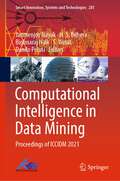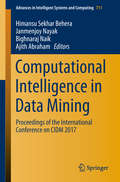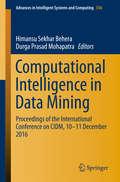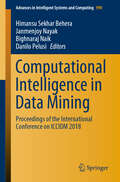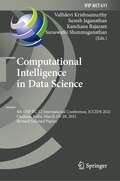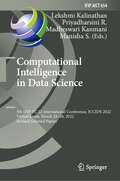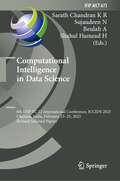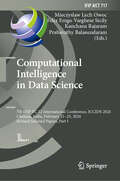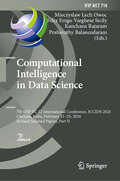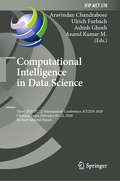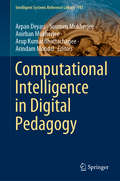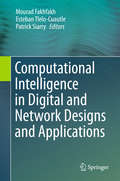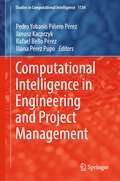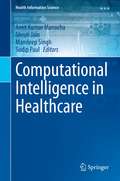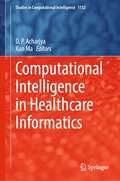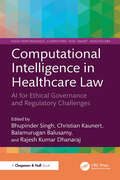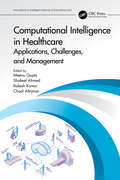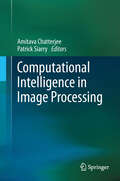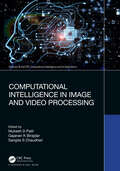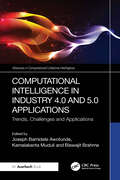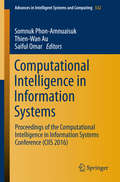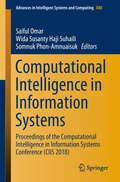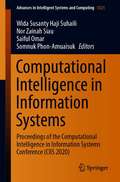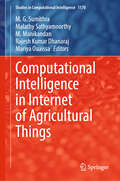- Table View
- List View
Computational Intelligence in Data Mining: Proceedings of ICCIDM 2021 (Smart Innovation, Systems and Technologies #281)
by Janmenjoy Nayak Bighnaraj Naik Danilo Pelusi H. S. Behera S. VimalThis book addresses different methods and techniques of integration for enhancing the overall goal of data mining. The book is a collection of high-quality peer-reviewed research papers presented in the Sixth International Conference on Computational Intelligence in Data Mining (ICCIDM 2021) held at Aditya Institute of Technology and Management, Tekkali, Andhra Pradesh, India, during December 11–12, 2021. The book addresses the difficulties and challenges for the seamless integration of two core disciplines of computer science, i.e., computational intelligence and data mining. The book helps to disseminate the knowledge about some innovative, active research directions in the field of data mining, machine and computational intelligence, along with some current issues and applications of related topics.
Computational Intelligence in Data Mining: Proceedings of the International Conference on CIDM 2017 (Advances in Intelligent Systems and Computing #711)
by Ajith Abraham Himansu Sekhar Behera Janmenjoy Nayak Bighnaraj NaikThe International Conference on “Computational Intelligence in Data Mining” (ICCIDM), after three successful versions, has reached to its fourth version with a lot of aspiration. The best selected conference papers are reviewed and compiled to form this volume. The proceedings discusses the latest solutions, scientific results and methods in solving intriguing problems in the fields of data mining, computational intelligence, big data analytics, and soft computing. The volume presents a sneak preview into the strengths and weakness of trending applications and research findings in the field of computational intelligence and data mining along with related field.
Computational Intelligence in Data Mining: Proceedings of the International Conference on CIDM 2017 (Advances in Intelligent Systems and Computing #711)
by Ajith Abraham Himansu Sekhar Behera Janmenjoy Nayak Bighnaraj NaikThe International Conference on “Computational Intelligence in Data Mining” (ICCIDM), after three successful versions, has reached to its fourth version with a lot of aspiration. The best selected conference papers are reviewed and compiled to form this volume. The proceedings discusses the latest solutions, scientific results and methods in solving intriguing problems in the fields of data mining, computational intelligence, big data analytics, and soft computing. The volume presents a sneak preview into the strengths and weakness of trending applications and research findings in the field of computational intelligence and data mining along with related field.
Computational Intelligence in Data Mining: Proceedings of the International Conference on CIDM, 10-11 December 2016 (Advances in Intelligent Systems and Computing #556)
by Himansu Sekhar Behera Durga Prasad MohapatraThe contributed volume aims to explicate and address the difficulties and challenges that of seamless integration of the two core disciplines of computer science, i. e. , computational intelligence and data mining. Data Mining aims at the automatic discovery of underlying non-trivial knowledge from datasets by applying intelligent analysis techniques. The interest in this research area has experienced a considerable growth in the last years due to two key factors: (a) knowledge hidden in organizations' databases can be exploited to improve strategic and managerial decision-making; (b) the large volume of data managed by organizations makes it impossible to carry out a manual analysis. The book addresses different methods and techniques of integration for enhancing the overall goal of data mining. The book helps to disseminate the knowledge about some innovative, active research directions in the field of data mining, machine and computational intelligence, along with some current issues and applications of related topics.
Computational Intelligence in Data Mining: Proceedings of the International Conference on ICCIDM 2018 (Advances in Intelligent Systems and Computing #990)
by Himansu Sekhar Behera Janmenjoy Nayak Bighnaraj Naik Danilo PelusiThis proceeding discuss the latest solutions, scientific findings and methods for solving intriguing problems in the fields of data mining, computational intelligence, big data analytics, and soft computing. This gathers outstanding papers from the fifth International Conference on “Computational Intelligence in Data Mining” (ICCIDM), and offer a “sneak preview” of the strengths and weaknesses of trending applications, together with exciting advances in computational intelligence, data mining, and related fields.
Computational Intelligence in Data Science: 4th IFIP TC 12 International Conference, ICCIDS 2021, Chennai, India, March 18–20, 2021, Revised Selected Papers (IFIP Advances in Information and Communication Technology #611)
by Vallidevi Krishnamurthy Suresh Jaganathan Kanchana Rajaram Saraswathi ShunmuganathanThis book constitutes the refereed post-conference proceedings of the Fourth IFIP TC 12 International Conference on Computational Intelligence in Data Science, ICCIDS 2021, held in Chennai, India, in March 2021. The 20 revised full papers presented were carefully reviewed and selected from 75 submissions. The papers cover topics such as computational intelligence for text analysis; computational intelligence for image and video analysis; blockchain and data science.
Computational Intelligence in Data Science: 5th IFIP TC 12 International Conference, ICCIDS 2022, Virtual Event, March 24–26, 2022, Revised Selected Papers (IFIP Advances in Information and Communication Technology #654)
by Lekshmi Kalinathan Priyadharsini R. Madheswari Kanmani Manisha S.This book constitutes the refereed post-conference proceedings of the Fifth IFIP TC 12 International Conference on Computational Intelligence in Data Science, ICCIDS 2022, held virtually, in March 2022. The 28 revised full papers presented were carefully reviewed and selected from 96 submissions. The papers cover topics such as computational intelligence for text analysis; computational intelligence for image and video analysis; blockchain and data science.
Computational Intelligence in Data Science: 6th IFIP TC 12 International Conference, ICCIDS 2023, Chennai, India, February 23–25, 2023, Revised Selected Papers (IFIP Advances in Information and Communication Technology #673)
by Sarath Chandran K R Sujaudeen N Beulah A Shahul Hamead HThis book constitutes the proceedings of the 6th IFIP TC 12 International Conference on Computational Intelligence in Data Science, ICCIDS 2023, which took place in Kalavakkam, India, in February 2023.The 24 full papers presented in this volume were carefully reviewed and selected from 134 submissions. The major theme of the conference was intended to be computation intelligence and knowledge management. Various emerging areas like IoT, cyber security and data science need computation intelligence to align with the cutting-edge research. Machine learning delivers insights hidden in data for rapid, automated responses and improved decision making. Machine learning for IoT can be used to project future trends, detect anomalies, and augment intelligence by ingesting image, video, and audio.
Computational Intelligence in Data Science: 7th IFIP TC 12 International Conference, ICCIDS 2024, Chennai, India, February 21–23, 2024, Revised Selected Papers, Part I (IFIP Advances in Information and Communication Technology #717)
by Mieczyslaw Lech Owoc Kanchana Rajaram Felix Enigo Varghese Sicily Prabavathy BalasundaramThese two-volume set IFIP AICT 717 and 718 constitutes the refereed post-conference proceedings of the 7th International Conference on Computational Intelligence in Data Science, ICCIDS 2024, held in Chennai, India, during February 21–23, 2024. The 63 full papers and 9 short papers presented in these proceedings were carefully reviewed and selected from 259 submissions. The conference papers are organized in following topical sections: Part I: Applications of AI/ML in Natural Language Processing; and Applications of AI/ML in Image Processing. Part II: Applications of AI/ML in KDM, Cloud Computing & Security; Data Analytics; and Applications of ML.
Computational Intelligence in Data Science: 7th IFIP TC 12 International Conference, ICCIDS 2024, Chennai, India, February 21–23, 2024, Revised Selected Papers, Part II (IFIP Advances in Information and Communication Technology #718)
by Mieczyslaw Lech Owoc Kanchana Rajaram Felix Enigo Varghese Sicily Prabavathy BalasundaramThese two-volume set IFIP AICT 717 and 718 constitutes the refereed post-conference proceedings of the 7th International Conference on Computational Intelligence in Data Science, ICCIDS 2024, held in Chennai, India, during February 21–23, 2024. The 63 full papers and 9 short papers were presented in these proceedings were carefully reviewed and selected from 259 submissions. The conference papers are organized in topical sections on: Part I - Applications of AI/ML in Natural Language Processing; and Applications of AI/ML in Image Processing. Part II - Applications of AI/ML in KDM, Cloud Computing & Security; Data Analytics; and Applications of ML.
Computational Intelligence in Data Science: Third IFIP TC 12 International Conference, ICCIDS 2020, Chennai, India, February 20–22, 2020, Revised Selected Papers (IFIP Advances in Information and Communication Technology #578)
by Ulrich Furbach Ashish Ghosh Aravindan Chandrabose Anand Kumar M.This book constitutes the refereed post-conference proceedings of the Third IFIP TC 12 International Conference on Computational Intelligence in Data Science, ICCIDS 2020, held in Chennai, India, in February 2020.The 19 revised full papers and 8 revised short papers presented were carefully reviewed and selected from 94 submissions. The papers are organized in the following topical sections: computational intelligence for text analysis; computational intelligence for image and video analysis; and data science.
Computational Intelligence in Digital Pedagogy (Intelligent Systems Reference Library #197)
by Anirban Mukherjee Arpan Deyasi Soumen Mukherjee Arup Kumar Bhattacharjee Arindam MondalThis book is a useful guide for the teaching fraternity, administrators and education technology professionals to make good use of AI across outcome-based technical education (OBTE) ecosystem and infuse innovations and affordable digital technologies to traditional pedagogic processes to make teaching-learning more independent of human factor (teacher/student quality), time and place and at the same time more impactful and enjoyable for the learners. Providing access to the digital media and learning tools (even to the extent of mobile apps) to the students would allow them to keep pace with innovations in learning technologies, learn according to their own pace and improve their understanding level and have instantaneous feedback and evaluation. The book explores these new challenges and scope of using computational intelligence in educational technology. The book also addresses how based on the data collected from the outcome of conventional educational system, intelligent diagnostic and feedback system is developed which will change the teaching strategies and corresponding teaching-learning process. The book covers a wider framework of digital pedagogy and its intelligent applications on various sectors of education system.
Computational Intelligence in Digital and Network Designs and Applications
by Esteban Tlelo-Cuautle Patrick Siarry Mourad FakhfakhThis book explains the application of recent advances in computational intelligence - algorithms, design methodologies, and synthesis techniques - to the design of integrated circuits and systems. It highlights new biasing and sizing approaches and optimization techniques and their application to the design of high-performance digital, VLSI, radio-frequency, and mixed-signal circuits and systems. This second of two related volumes addresses digital and network designs and applications, with 12 chapters grouped into parts on digital circuit design, network optimization, and applications. It will be of interest to practitioners and researchers in computer science and electronics engineering engaged with the design of electronic circuits.
Computational Intelligence in Engineering and Project Management (Studies in Computational Intelligence #1134)
by Janusz Kacprzyk Rafael Bello Pérez Pedro Yobanis Piñero Pérez Iliana Pérez PupoThis book is dedicated to all those interested in the application of artificial intelligence in engineering and project management. Most of the jobs are focused on achieving agile project development. New algorithms that combine various computational intelligence techniques are applied in different areas of knowledge in project management.In this book, computational intelligence is presented as the branch of AI that encompasses various techniques aimed at simulating human tolerance in decision-making processes in environments with uncertainty and imprecision. Among the precursor techniques of computational intelligence are: evolutionary algorithms, artificial neural networks, fuzzy set theory, and fuzzy systems. However, other areas such as the rough set, linguistic data summary, natural language processing, the conversational systems, fuzzy cognitive maps, collective intelligence, the neutrosophic theory, and other fuzzy logic extensions are contributing to the application and extension of computational intelligenceThe book is organized into three parts, as shown below. The first part constitutes a critical review of computational intelligence in project management. The second part presents new computational intelligence techniques and their applications in project planning, control, and monitoring processes. In particular, the use of conversational systems and their applicability in the agile management of portfolio programs and projects stand out. Part three of the book exemplifies the use of computing techniques with words and other computational intelligence techniques for organizational decision-making.The authors of the book stand out for their extensive experience in the development of basic and applied applications of computational intelligence. The authors Janusz Kacprzyk, Pedro Y. Piñero Pérez, Rafael E. Bello Pérez, and Iliana Pérez Pupo have published several books associated with artificial intelligence and computational intelligence applied to projects. They continue working on fundamental-oriented and applied research on different artificial intelligence techniques to help with decision-making in different areas of knowledge.Authors would like to thank all the engineers, professors, and researchers without whose efforts this book could not have been written.
Computational Intelligence in Healthcare (Health Information Science)
by Sudip Paul Shruti Jain Amit Kumar Manocha Mandeep SinghArtificial intelligent systems, which offer great improvement in healthcare sector assisted by machine learning, wireless communications, data analytics, cognitive computing, and mobile computing provide more intelligent and convenient solutions and services. With the help of the advanced techniques, now a days it is possible to understand human body and to handle & process the health data anytime and anywhere. It is a smart healthcare system which includes patient, hospital management, doctors, monitoring, diagnosis, decision making modules, disease prevention to meet the challenges and problems arises in healthcare industry. Furthermore, the advanced healthcare systems need to upgrade with new capabilities to provide human with more intelligent and professional healthcare services to further improve the quality of service and user experience. To explore recent advances and disseminate state-of-the-art techniques related to intelligent healthcare services and applications. This edited book involved in designing systems that will permit the societal acceptance of ambient intelligence including signal processing, imaging, computing, instrumentation, artificial intelligence, internet of health things, data analytics, disease detection, telemedicine, and their applications. As the book includes recent trends in research issues and applications, the contents will be beneficial to Professors, researchers, and engineers. This book will provide support and aid to the researchers involved in designing latest advancements in communication and intelligent systems that will permit the societal acceptance of ambient intelligence. This book presents the latest research being conducted on diverse topics in intelligence technologies with the goal of advancing knowledge and applications healthcare sector and to present the latest snapshot of the ongoing research as well as to shed further light on future directions in this space. The aim of publishing the book is to serve for educators, researchers, and developers working in recent advances and upcoming technologies utilizing computational sciences.
Computational Intelligence in Healthcare Informatics (Studies in Computational Intelligence #1132)
by Kun Ma D. P. AcharjyaThe book presents advancements in computational intelligence in perception with healthcare applications. Besides, the concepts, theory, and applications in various domains of healthcare systems including decision making in healthcare management, disease diagnosis, and electronic health records will be presented in a lucid manner. To achieve these objectives, both theoretical advances and its applications to healthcare problems will be stressed upon. This has been done to make the edited book more flexible and to stimulate further research interest in topics. The book is divided into four sections such as theoretical foundation of computational intelligence techniques, computational intelligence in analyzing health data, computational intelligence in electronic health record (EHR), and computational intelligence in ethical issues in health care.
Computational Intelligence in Healthcare Law: AI for Ethical Governance and Regulatory Challenges (High-Performance Computing for Smart Healthcare)
by Christian Kaunert Bhupinder Singh Balamurugan Balusamy Rajesh Kumar DhanarajThis book explores the intersection of legal frameworks, healthcare innovation, and computational intelligence, shedding light on how emerging technologies like artificial intelligence (AI) and machine learning (ML) are reshaping the medical landscape. It presents real- life challenges such as patient privacy, data security, and compliance issues in smart healthcare by delving into the associated ethical and regulatory implications. Comprising the concepts of predictive analytics, regulatory compliance algorithms, and legal decision- making processes, this book offers a roadmap for stakeholders to navigate the evolving landscape of healthcare innovation responsibly and ethically.Features: Investigates how artificial intelligence supports legal decision- making processes in smart healthcare, addressing ethical and accountability concerns Demonstrates the use of smart contracts and automation tools powered by computational intelligence to streamline legal processes and ensure compliance in smart healthcare initiatives Focuses on managing healthcare data within legal frameworks, emphasizing the role of computational intelligence’s in ensuring privacy and security Examines how computational intelligence enables predictive analytics models to anticipate legal challenges and compliance issues in smart healthcare Highlights the development and implementation of computational algorithms for navigating evolving legal frameworks in healthcare This reference book is a useful resource for scholars and researchers working on smart healthcare.
Computational Intelligence in Healthcare: Applications, Challenges, and Management (Innovations in Intelligent Internet of Everything (IoE))
by Rakesh Kumar Shakeel Ahmed Meenu Gupta Chadi AltrjmanComputational intelligence (CI) refers to the ability of computers to accomplish tasks that are normally completed by intelligent beings such as humans and animals. Artificial intelligent systems offer great improvement in healthcare systems by providing more intelligent and convenient solutions and services assisted by machine learning, wireless communications, data analytics, cognitive computing, and mobile computing. Modern health treatments are faced with the challenge of acquiring, analysing, and applying the large amount of knowledge necessary to solve complex problems. AI techniques are being effectively used in the field of healthcare systems by extracting the useful information from the vast amounts of data by applying human expertise and CI methods, such as fuzzy models, artificial neural networks, evolutionary algorithms, and probabilistic methods which have recently emerged as promising tools for the development and application of intelligent systems in healthcare practice. This book starts with the fundamentals of computer intelligence and the techniques and procedures associated with them. Contained in the book are state-of-the-art CI methods and other allied techniques used in healthcare systems as well as advances in different CI methods that confront the problem of effective data analysis and storage faced by healthcare institutions. The objective of this book is to provide the latest research related to the healthcare sector to researchers and engineers with a platform encompassing state-of-the-art innovations, research and design, and the implementation of methodologies.
Computational Intelligence in Image Processing
by Patrick Siarry Amitava ChatterjeeComputational intelligence based techniques have firmly established themselves as viable, alternate, mathematical tools for more than a decade. They have been extensively employed in many systems and application domains, among these signal processing, automatic control, industrial and consumer electronics, robotics, finance, manufacturing systems, electric power systems, and power electronics. Image processing is also an extremely potent area which has attracted the attention of many researchers who are interested in the development of new computational intelligence-based techniques and their suitable applications, in both research problems and in real-world problems. Part I of the book discusses several image preprocessing algorithms; Part II broadly covers image compression algorithms; Part III demonstrates how computational intelligence-based techniques can be effectively utilized for image analysis purposes; and Part IV shows how pattern recognition, classification and clustering-based techniques can be developed for the purpose of image inferencing. The book offers a unified view of the modern computational intelligence techniques required to solve real-world problems and it is suitable as a reference for engineers, researchers and graduate students.
Computational Intelligence in Image and Video Processing (Chapman & Hall/CRC Computational Intelligence and Its Applications)
by Mukesh D Patil Gajanan K Birajdar Sangita S ChaudhariComputational Intelligence in Image and Video Processing presents introduction, state-of-the-art and adaptations of computational intelligence techniques and their usefulness in image and video enhancement, classification, retrieval, forensics and captioning. It covers an amalgamation of such techniques in diverse applications of image and video processing. Features: A systematic overview of state-of-the-art technology in computational intelligence techniques for image and video processing Advanced evolutionary and nature-inspired approaches to solve optimization problems in the image and video processing domain Outcomes of recent research and some pointers to future advancements in image and video processing and intelligent solutions using computational intelligence techniques Code snippets of the computational intelligence algorithm/techniques used in image and video processing This book is primarily aimed at advanced undergraduates, graduates and researchers in computer science and information technology. Engineers and industry professionals will also find this book useful.
Computational Intelligence in Industry 4.0 and 5.0 Applications: Trends, Challenges and Applications (Advances in Computational Collective Intelligence)
by Kamalakanta Muduli Joseph Bamidele Awotunde Biswajit BrahmaIndustry 4.0 and 5.0 applications will revolutionize production, enabling smart manufacturing machines to interact with their environments. These machines will become self-aware, self-learning, and capable of real-time data interpretation for self-diagnosis and prevention of production issues. They will also self-calibrate and prioritize tasks to enhance production quality and efficiency.Computational Intelligence in Industry 4.0 and 5.0 Applications examines applications that merge three key disciplines: computational intelligence (CI), Industry 4.0, and Industry 5.0. It presents solutions using Industrial Internet of Things (IIoT) technologies, augmented by CI-based techniques, modeling, controls, estimations, applications, systems, and future scopes. These applications use data from smart sensors, processed through enhanced CI methods, to make smart automation more effective.Industry 4.0 integrates data and intelligent automation into manufacturing, using technologies like CI, the IoT, the IIoT, and cloud computing. It transforms data into actionable insights for decision-making and process optimization, essential for modern competitive businesses managing high-speed data integration in production processes. Currently, Industries 4.0 and 5.0 are undergoing significant transformations due to advances in applying artificial intelligence (AI), big data analytics, telecommunication technologies, and control theory. These applications are increasingly multidisciplinary, integrating mechanical, control, and information technologies. However, they face such technical challenges as parametric uncertainties, external disturbances, sensor noise, and mechanical failures. To address these, this book examines such CI technologies as fuzzy logic, neural networks, and reinforcement learning and their application to modeling, control, and estimation. It also covers recent advancements in IIoT sensors, microcontrollers, and big data analytics that further enhance CI-based solutions in Industry 4.0 and 5.0 systems.
Computational Intelligence in Information Systems: Proceedings of the Computational Intelligence in Information Systems Conference (CIIS 2016) (Advances in Intelligent Systems and Computing #532)
by Somnuk Phon-Amnuaisuk Thien-Wan Au Saiful OmarThis book constitutes the Proceedings of the Computational Intelligence in Information Systems conference (CIIS 2016), held in Brunei, November 18-20, 2016. The CIIS conference provides a platform for researchers to exchange the latest ideas and to present new research advances in general areas related to computational intelligence and its applications. The 26 revised full papers presented in this book have been carefully selected from 62 submissions. They cover a wide range of topics and application areas in computational intelligence and informatics.
Computational Intelligence in Information Systems: Proceedings of the Computational Intelligence in Information Systems Conference (CIIS 2018) (Advances in Intelligent Systems and Computing #888)
by Somnuk Phon-Amnuaisuk Saiful Omar Wida Susanty Haji SuhailiThis book constitutes the Proceeding of the Computational Intelligence in Information Systems conference (CIIS 2018), held in Brunei, November 16 - 18, 2018. The CIIS conference provides a platform for researchers to exchange the latest ideas and to present new research advances in general areas related to computational intelligence and its application. The 19 revised papers presented in this book have been carefully selected from 41 submissions. The Conference contributes to major fields of the Computing and Information Systems in theoretical and practical aspects. This include Computational Intelligence Techniques, Data Mining, Big Data, the Internet of Things (IoTs), Machine Learning, Predictive Analytics, Product and Design technology, Smart Products, Human Centered Design (HCD), Additive Manufacturing, Information Security, Computer Networks and Cyber Technologies.
Computational Intelligence in Information Systems: Proceedings of the Computational Intelligence in Information Systems Conference (CIIS 2020) (Advances in Intelligent Systems and Computing #1321)
by Saiful Omar Wida Susanty Haji Suhaili Nor Zainah Siau Somnuk Phon-AmuaisukThis book constitutes the Proceeding of the Computational Intelligence in Information Systems conference (CIIS 2020), held in Brunei, January 25–27, 2021. The CIIS conference provides a platform for researchers to exchange the latest ideas and to present new research advances in general areas related to computational intelligence and its applications. The 23 revised papers presented in this book have been carefully selected from 55 submissions.
Computational Intelligence in Internet of Agricultural Things (Studies in Computational Intelligence #1170)
by Mariya Ouaissa M. G. Sumithra Rajesh Kumar Dhanaraj Malathy Sathyamoorthy M. ManikandanThis book focuses on the integration of IoT and AI techniques to generate greater data-driven solutions for the agriculture industry. It also focuses on computational intelligence (CI), machine learning, and AI techniques along with current applications, obstacles, and potential challenges and solutions for agricultural industries. These technologies have the potential to curtail resource wastage and contribute to addressing the challenges of feeding the expanding global population. This book acts as a resource to augment the reader's comprehension of the role of emerging IT technologies in the agricultural sector. This book also covers key technologies and techniques such as AI, ML, and IoT in the development of smart agriculture and provides information on various types of smart farming technology, platforms, and machine learning algorithms with case studies based on real-time problems.
